标签:注册 快速 命名 主动性 注入 index java配置 切面 简单
官网:https://spring.io/projects/spring-framework
<!-- https://mvnrepository.com/artifact/org.springframework/spring-webmvc -->
<dependency>
<groupId>org.springframework</groupId>
<artifactId>spring-webmvc</artifactId>
<version>5.2.3.RELEASE</version>
</dependency>
<!-- https://mvnrepository.com/artifact/org.springframework/spring-jdbc -->
<dependency>
<groupId>org.springframework</groupId>
<artifactId>spring-jdbc</artifactId>
<version>5.2.3.RELEASE</version>
</dependency>
总结:Spring就是一个轻量级的控制反转和面向切面编程的框架
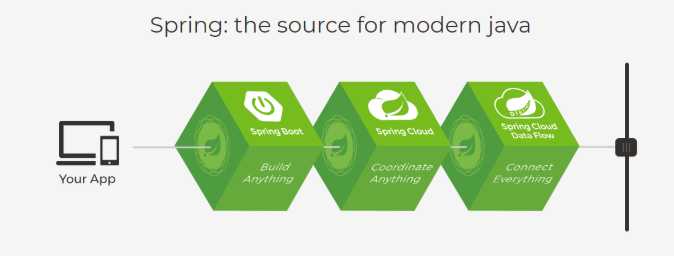
弊端:发展了太多之后,违背了原来的理念!配置十分繁琐,人称:"配置地狱"
用户不同的需求可能会导致我们不断的修改源码,会存在成本问题
可以使用Set接口实现,让用户自己调用,选择
@Data
public class UserServiceImpl implements UserService {
// private UserDao userDao = new UserDaoMysqlImpl();
private UserDao userDao;
public void getUser() {
userDao.getUser();
}
}这种思想,本质上解决问题!系统耦合度大大降低,可以更加专注在业务的实现上!
控制反转IOC(Inversion of Control),是一种设计思想,DI(依赖注入)是实现IOC的一种方法,
控制反转后将对象交第三方,控制反转就是:获得依赖对象的方式反转了。
采用XML方式配置Bean的时候,Bean的定义信息是和实现分离的,而采用注解的方式可以把两者合为一体,Bean的定义信息直接以注解的形式定义在实现类中,从而达到了零配置的目的。
控制反转是一种通过描述(XML或注解)并通过第三方去生产或获取特点对象的方式。在Spring中实现控制反转的是IOC容器,而实现的方法是依赖注入(Dependency Injection DI)
配置文件
<?xml version="1.0" encoding="UTF-8"?>
<beans xmlns="http://www.springframework.org/schema/beans"
xmlns:xsi="http://www.w3.org/2001/XMLSchema-instance"
xsi:schemaLocation="http://www.springframework.org/schema/beans
https://www.springframework.org/schema/beans/spring-beans.xsd">
<!-- 使用spring创建对象,在spring中这些都称之为bean-->
<!--
bean 相当于 对象 new 对象
id 相当于 变量名
class 相当于 全限定
property 相当于 给对象中的属性赋初始值
value
-->
<bean id="hello" class="cn.imut.pojo.Hello">
<property name="str" value="Spring"/>
</bean>
</beans>c测试
public class MyTest {
public static void main(String[] args) {
//用xml加载必须使用(获取Spring的上下文对象)
ApplicationContext context = new ClassPathXmlApplicationContext("beans.xml");
//我们的对象都在Spring中管理了,若要使用,直接取出即可
Hello hello = (Hello) context.getBean("hello");
System.out.println(hello.toString());
}
}这个过程称之为控制反转
控制:谁来控制对象的创建,传统应用程序的对象是由程序本身控制创建,使用Spring后,对象由Spring来创建!
反转:程序本身不创建对象,而变成被动的接收对象。
依赖注入:就是利用Set方法来进行注入的。
IOC是一种编程思想,由主动的编程变成被动的接收
若要使用有参构造
下标赋值
<!-- 下标赋值-->
<bean id="user" class="cn.imut.pojo.User">
<constructor-arg index="0" value="张磊"/>
</bean>类型创建
<!-- 不建议使用-->
<bean id="user" class="cn.imut.pojo.User">
<constructor-arg type="java.lang.String" value="张磊"/>
</bean>直接通过参数名设置
<bean id="user" class="cn.imut.pojo.User">
<constructor-arg name="name" value="张磊"/>
</bean>总结:在配置文件加载的时候,容器中管理对象就已经初始化了
<!-- 别名-->
<alias name="user" alias="user2"/> <!--
id : bean的唯一标识符,相当于对象名
class : 全限定名 包名 + 类名
name : 也是别名,name可以同时起多个别名
-->
<bean id="userT" class="cn.imut.pojo.User" name="user3 u2,u3;u4">
<property name="name" value="1"/>
</bean>一般用于团队,它可以将多个配置文件,导入合并为一个
假设项目有多人开发,这三个人复制不同的类开发,不同的类需要注册在不同的bean中,我们可以利用import将所有人的beans.xml合并为一个总的 applicationContext.xml
使用时,直接用总的配置即可
前面已经说明
【环境搭建】
复杂类型
@Data
public class Address {
private String address;
}真实测试对象
@Data
@SuppressWarnings("all")
public class Student {
private String name;
private Address address;
private String[] books;
private List<String> hobbys;
private Map<String,String> card;
private Set<String> games;
private Properties info;
private String wife; //空指针
}beans.xml
<?xml version="1.0" encoding="UTF-8"?>
<beans xmlns="http://www.springframework.org/schema/beans"
xmlns:xsi="http://www.w3.org/2001/XMLSchema-instance"
xsi:schemaLocation="http://www.springframework.org/schema/beans
https://www.springframework.org/schema/beans/spring-beans.xsd">
<bean id="address" class="cn.imut.pojo.Address">
<property name="address" value="呼和浩特"/>
</bean>
<bean id="student" class="cn.imut.pojo.Student">
<!-- 第一种,普通值注入,value-->
<property name="name" value="张磊"/>
<!-- 第二种,bean注入,ref-->
<property name="address" ref="address"/>
<!-- 第三种,数组注入-->
<property name="books">
<array>
<value>红楼梦</value>
<value>水浒传</value>
<value>三国演义</value>
<value>西游记</value>
</array>
</property>
<!-- 第四种,List注入-->
<property name="hobbys">
<list>
<value>吃</value>
<value>喝</value>
<value>玩</value>
<value>乐</value>
</list>
</property>
<!-- 第五种,Map注入-->
<property name="card">
<map>
<entry key="身份证" value="123"/>
<entry key="QQ号" value="1234"/>
</map>
</property>
<!-- 第六种,Set注入-->
<property name="games">
<set>
<value>LOL</value>
<value>CF</value>
</set>
</property>
<!-- 第七种,null-->
<property name="wife">
<null/>
</property>
<!-- 第八种,properties-->
<property name="info">
<props>
<prop key="学号">123456</prop>
<prop key="姓名">张磊</prop>
<prop key="性别">男</prop>
</props>
</property>
</bean>
</beans>测试类
public class MyTest {
public static void main(String[] args) {
ApplicationContext context = new ClassPathXmlApplicationContext("beans.xml");
Student student = (Student) context.getBean("student");
System.out.println(student.toString());
}
}可以使用p或者c命名空间
<!-- p命名空间注入,可以直接注入属性-->
<bean id="user" class="cn.imut.pojo.User" p:name="张磊" p:age="18">
</bean>
<!-- c命名注入,通过构造器注入-->
<bean id="user2" class="cn.imut.pojo.User" c:age="18" c:name="张磊">
</bean>注意:p,c命名空间不能和直接使用,需要导入约束
xmlns:p="http://www.springframework.org/schema/p"
xmlns:c="http://www.springframework.org/schema/c"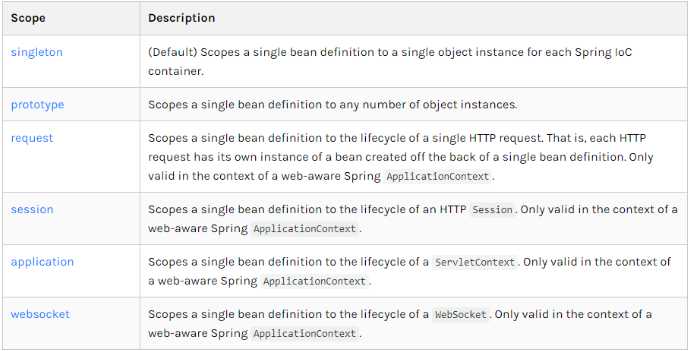
单例模式(默认)
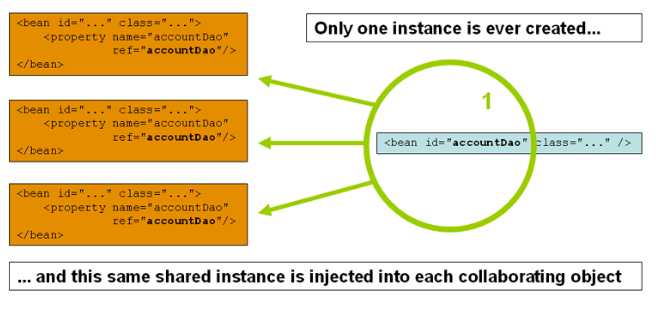
<bean id="user2" class="cn.imut.pojo.User" c:age="18" c:name="张磊" scope="singleton">原型模式
<bean id="user2" class="cn.imut.pojo.User" c:age="18" c:name="张磊" scope="prototype">每次从容器get时,都会产生一个新的对象
其余的request、session、application只能在Web开发中使用到!
在Spring中有三种自动装配方式
环境搭建:一个人两个宠物
<!--
ByName:会自动在容器上下文中查找,和自己对象set方法后面的值对应的beanid
-->
<bean id="people" class="cn.imut.pojo.People" autowire="byName">
<property name="name" value="张磊"/>
</bean>byType:会自动在容器上下文中查找,和自己对象属性相同的对应的beanid <bean id="people" class="cn.imut.pojo.People" autowire="byType">
<property name="name" value="张磊"/>
</bean>小结:
The introduction of annotation-based configuration raised the question of whether this approach is “better” than XML.
要使用注解须知:
导入约束:context
<context:annotation-config/>配置注解的支持
<?xml version="1.0" encoding="UTF-8"?>
<beans xmlns="http://www.springframework.org/schema/beans"
xmlns:xsi="http://www.w3.org/2001/XMLSchema-instance"
xmlns:context="http://www.springframework.org/schema/context"
xsi:schemaLocation="http://www.springframework.org/schema/beans
https://www.springframework.org/schema/beans/spring-beans.xsd
http://www.springframework.org/schema/context
https://www.springframework.org/schema/context/spring-context.xsd">
<context:annotation-config/>
</beans>@Autowired:
直接在属性上使用即可,也可以在set方式上使用
可以不用写set方法,前提是在IOC容器中存在,且符合ByType
如果@Autowired自动装配的环境比较复杂,自动装配无法通过一个注解完成时
@Nullable: 字段标记此注解,字段可以为null使用@Qualifier配合使用
@Qualifier(value = "dog1") @Resource
java自带注解,没有Spring方便
小结:
@Resource和@Autowired的区别:
在Spring4之后,要使用注解开发,必须要保证aop的包导入了
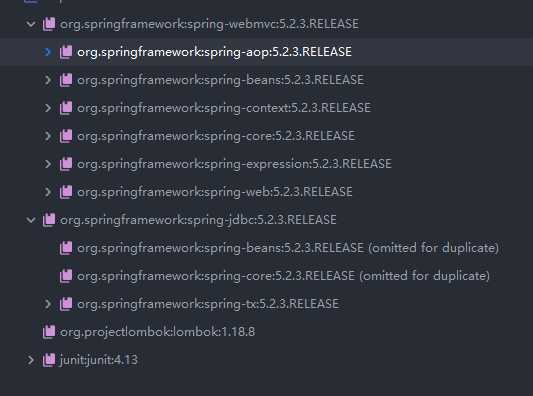
使用注解需要导入context约束,增加注解的支持
<?xml version="1.0" encoding="UTF-8"?>
<beans xmlns="http://www.springframework.org/schema/beans"
xmlns:xsi="http://www.w3.org/2001/XMLSchema-instance"
xmlns:context="http://www.springframework.org/schema/context"
xsi:schemaLocation="http://www.springframework.org/schema/beans
https://www.springframework.org/schema/beans/spring-beans.xsd
http://www.springframework.org/schema/context
https://www.springframework.org/schema/context/spring-context.xsd">
<context:annotation-config/>
</beans>@Data
@Component
// @Component 组件
public class User {
//相当于bean中的注入
@Value("张磊")
public String name;
}@Component有几个衍生注解,我们在Web开发中,会按照MVC三层架构分层
这四个功能是一样的,都代表将某个类注册到Spring容器中,装配Bean
@Autowired:自动装配,通过类型
@Qualifier:配合使用,可以具体指定
@Nullable: 字段标记此注解,字段可以为null
@Resource:自动装配@Data
@Component
// @Component 组件
@Scope("singleton") //单例
public class User {
//相当于bean中的注入
@Value("张磊")
public String name;
}JavaConfig是Spring的一个子项目,在Spring4之后,成为了核心功能
@Configuration
public class MyConfig {
@Bean
public User getUser() {
return new User();
}
}纯Java配置,在SpringBoot中随处可见
代理模式是SpringAOP的底层!

角色分析:
代码步骤:
接口
//租房
public interface Rent {
public void rent();
}真实角色
//房东
public class Host implements Rent{
public void rent() {
System.out.println("房东要出租房子");
}
}代理角色
public class Proxy implements Rent{
private Host host;
public Proxy() {
}
public Proxy(Host host) {
this.host = host;
}
public void rent() {
seeHouse();
host.rent();
hetong();
fare();
}
//看房
public void seeHouse() {
System.out.println("中介带你去看房");
}
//收中介费
public void fare() {
System.out.println("收中计费");
}
//签合同
public void hetong() {
System.out.println("签合同");
}
}客户端访问代理角色
public class Client {
public static void main(String[] args) {
//房东要租房子
Host host = new Host();
//代理,中介帮房租房子,代理角色一般有一些附属操作
Proxy proxy = new Proxy(host);
//不用面对房东,直接找中介租房即可
proxy.rent();
}
}代理模式的好处:
缺点:

需要了解两个类:Proxy:代理,InvocationHandler:调用处理程序
AOP(Aspect Oriented Programming) 意为:面向切面编程
是通过预编译方式和运行期动态代理实现程序功能的统一维护的一种技术。
AOP是OOP的一种延续,是软件开发的一个热点,也是Spring框架中的一个重要内容,是函数式编程的一种衍生范型。
利用AOP可以对业务逻辑的各个部分进行隔离,从而使得业务逻辑各个部分之间的耦合度降低,提高程序的可重用性,同时提高开发效率。
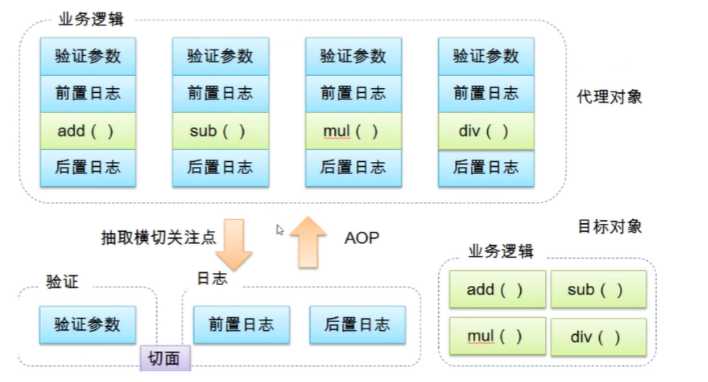
提供声明式事务:允许用户自定义切面

需要导入依赖包
<dependency>
<groupId>org.aspectj</groupId>
<artifactId>aspectjweaver</artifactId>
<version>1.9.4</version>
</dependency>方式一:使用Spring的接口
<?xml version="1.0" encoding="UTF-8"?>
<beans xmlns="http://www.springframework.org/schema/beans"
xmlns:xsi="http://www.w3.org/2001/XMLSchema-instance"
xmlns:aop="http://www.springframework.org/schema/aop"
xsi:schemaLocation="http://www.springframework.org/schema/beans
https://www.springframework.org/schema/beans/spring-beans.xsd
http://www.springframework.org/schema/aop
https://www.springframework.org/schema/aop/spring-aop.xsd"> <!-- 注册bean-->
<bean id="userService" class="cn.imut.service.UserServiceImpl"/>
<bean id="log" class="cn.imut.log.Log"/>
<bean id="afterLog" class="cn.imut.log.AfterLog"/> <!-- 方式一、使用原生Spring API 接口-->
<!-- 配置aop 需要导入aop的配置-->
<aop:config>
<!-- 切入点:expression:表达式 execution(要执行的位置)-->
<aop:pointcut id="pointcut" expression="execution(* cn.imut.service.UserServiceImpl.*(..))"/>
<!-- 执行环绕增强-->
<aop:advisor advice-ref="log" pointcut-ref="pointcut"/>
<aop:advisor advice-ref="afterLog" pointcut-ref="pointcut"/>
</aop:config>测试
public class MyTest {
public static void main(String[] args) {
ApplicationContext context = new ClassPathXmlApplicationContext("ApplicationContext.xml");
//动态代理代理的是接口!
UserService userService = (UserService) context.getBean("userService");
userService.add();
}
}方式二:使用自定义类(主要是切面定义)
<!-- 方式二、自定义类-->
<bean id="diy" class="cn.imut.diy.DiyPointCut"/>
<aop:config>
<!-- 自定义切面,ref 要引用的类-->
<aop:aspect ref="diy">
<!-- 切入点-->
<aop:pointcut id="point" expression="execution(* cn.imut.service.UserServiceImpl.*(..))"/>
<!-- 通知-->
<aop:before method="before" pointcut-ref="point"/>
<aop:after method="after" pointcut-ref="point"/>
</aop:aspect>
</aop:config>测试
public class MyTest {
public static void main(String[] args) {
ApplicationContext context = new ClassPathXmlApplicationContext("ApplicationContext.xml");
//动态代理代理的是接口!
UserService userService = (UserService) context.getBean("userService");
userService.add();
}
}方式三:使用注解实现
<!-- 方式三注册-->
<bean id="annotationPointCut" class="cn.imut.diy.AnnotationPoint"/>
<!-- 开启注解支持-->
<aop:aspectj-autoproxy/>@Aspect //标注这个类是一个切面
public class AnnotationPoint {
@Before("execution(* cn.imut.service.UserServiceImpl.*(..))")
public void before() {
System.out.println("该方法执行前");
}
}eg2
//用户记录日志的公共类
@Component("logger")
@Aspect //当前类是一个切面类
public class Logger {
//用于打印日志,计划让其在切入点方法执行之前执行
@Pointcut("execution(* cn.imut.service.Impl.*.*(..))")
public void pt1() {
System.out.println("哈哈");
}
@Before("pt1()")
public void printLog() {
System.out.println("Logger类中的printLog方法开始记录日志了");
}
}步骤:
环境:
<dependencies>
<dependency>
<groupId>org.mybatis</groupId>
<artifactId>mybatis</artifactId>
<version>3.5.3</version>
</dependency>
<dependency>
<groupId>mysql</groupId>
<artifactId>mysql-connector-java</artifactId>
<version>5.1.47</version>
</dependency>
<!-- https://mvnrepository.com/artifact/org.mybatis/mybatis-spring -->
<dependency>
<groupId>org.mybatis</groupId>
<artifactId>mybatis-spring</artifactId>
<version>2.0.3</version>
</dependency>
<!-- https://mvnrepository.com/artifact/org.springframework/spring-webmvc -->
<dependency>
<groupId>org.springframework</groupId>
<artifactId>spring-webmvc</artifactId>
<version>5.2.3.RELEASE</version>
</dependency>
<!-- https://mvnrepository.com/artifact/org.springframework/spring-jdbc -->
<dependency>
<groupId>org.springframework</groupId>
<artifactId>spring-jdbc</artifactId>
<version>5.2.3.RELEASE</version>
</dependency>
<dependency>
<groupId>org.projectlombok</groupId>
<artifactId>lombok</artifactId>
<version>1.18.8</version>
</dependency>
<dependency>
<groupId>org.aspectj</groupId>
<artifactId>aspectjweaver</artifactId>
<version>1.9.4</version>
</dependency>
<dependency>
<groupId>junit</groupId>
<artifactId>junit</artifactId>
<version>4.13</version>
</dependency>
</dependencies>编写数据源配置
<bean id="dataSource" class="org.springframework.jdbc.datasource.DriverManagerDataSource">
<property name="driverClassName" value="com.mysql.jdbc.Driver"/>
<property name="url" value="jdbc:mysql://localhost:3306/mybatis?useSSL=false&useUnicode=true&characterEncoding=UTF-8&serverTimezone=UTC"/>
<property name="username" value="root"/>
<property name="password" value="1870535196"/>
</bean>sqlSessionFactory
<bean id="sqlSessionFactory" class="org.mybatis.spring.SqlSessionFactoryBean">
<property name="dataSource" ref="dataSource"/>
<!-- 绑定Mybatis 配置文件
可以替代Mybatis配置文件
-->
<property name="configLocation" value="classpath:mybatis-config.xml"/>
<property name="mapperLocations" value="classpath:cn/imut/mapper/UserMapper.xml"/>
</bean>sqlSessionTemplate
<!-- SqlSessionTemplate:就是我们使用的sqlSession-->
<bean id="sqlSession" class="org.mybatis.spring.SqlSessionTemplate">
<!-- 只能通过构造器注入,因为没有set方法-->
<constructor-arg index="0" ref="sqlSessionFactory"/>
</bean>接口加实现类
public interface UserMapper {
public List<User> selectUser();
}public class UserMapperImpl implements UserMapper{
//我们的所有操作都使用SqlSession来执行
private SqlSessionTemplate sqlSession;
public void setSqlSession(SqlSessionTemplate sqlSession) {
this.sqlSession = sqlSession;
}
public List<User> selectUser() {
UserMapper mapper = sqlSession.getMapper(UserMapper.class);
return mapper.selectUser();
}
} <bean id="userMapper" class="cn.imut.mapper.UserMapperImpl">
<property name="sqlSession" ref="sqlSession"/>
</bean>实现类注入Spring,测试
@Test
public void selectAll() {
ApplicationContext context = new ClassPathXmlApplicationContext("spring-dao.xml");
UserMapper userMapper = context.getBean("userMapper", UserMapper.class);
for (User user : userMapper.selectUser()) {
System.out.println(user);
}
}方式二
public class UserMapperImpl2 extends SqlSessionDaoSupport implements UserMapper{
public List<User> selectUser() {
SqlSession session = getSqlSession();
UserMapper mapper = session.getMapper(UserMapper.class);
return mapper.selectUser();
}
} <bean id="userMapper2" class="cn.imut.mapper.UserMapperImpl2">
<property name="sqlSessionFactory" ref="sqlSessionFactory"/>
</bean>
<!-- 配置声明式事务-->
<bean id="transactionManager" class="org.springframework.jdbc.datasource.DataSourceTransactionManager">
<constructor-arg ref="dataSource"/>
</bean>
<!-- 结合AOP实现事务的植入-->
<!-- 配置事务的类-->
<tx:advice id="txAdvice" transaction-manager="transactionManager">
<!-- 配置事务的传播特性 propagation 传播-->
<tx:attributes>
<tx:method name="add" propagation="REQUIRED"/>
<tx:method name="update"/>
<tx:method name="delete"/>
<tx:method name="*"/>
</tx:attributes>
</tx:advice>
<!-- 配置事务切入-->
<aop:config>
<aop:pointcut id="txPointCut" expression="execution(* cn.imut.mapper.*.*(..))"/>
<aop:advisor advice-ref="txAdvice" pointcut-ref="txPointCut"/>
</aop:config>标签:注册 快速 命名 主动性 注入 index java配置 切面 简单
原文地址:https://www.cnblogs.com/yfyyy/p/12335066.html